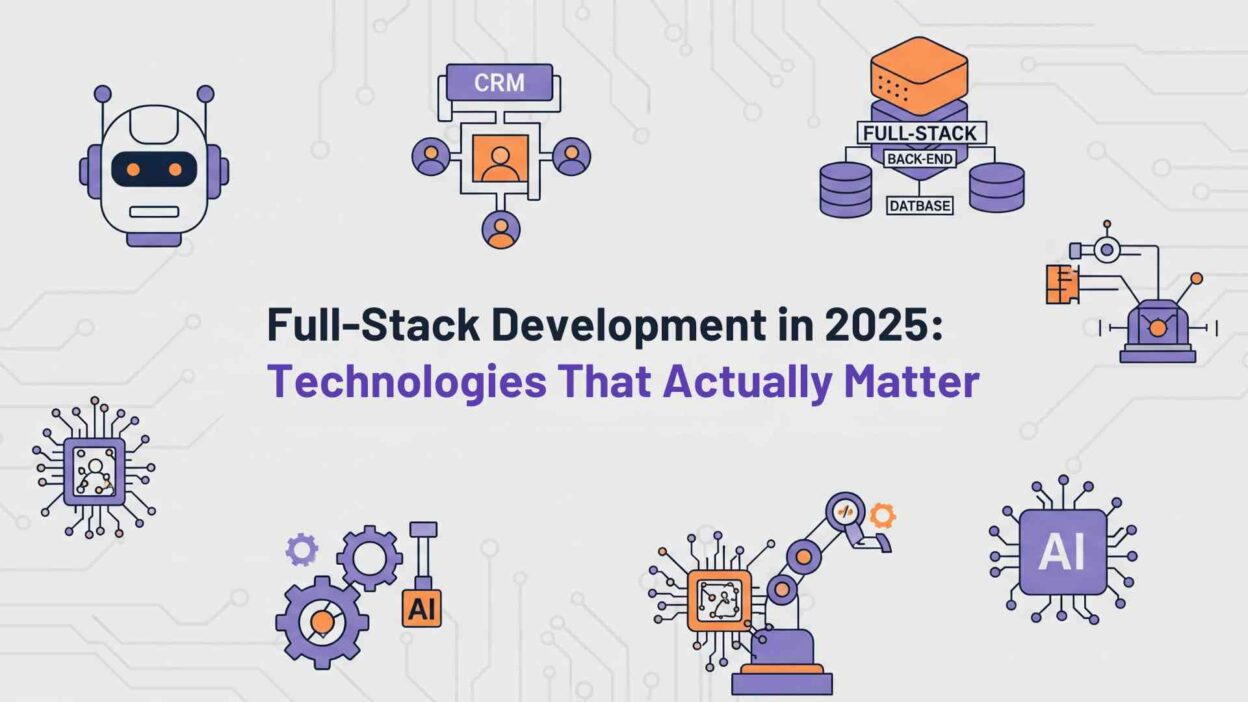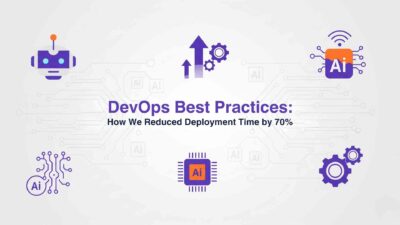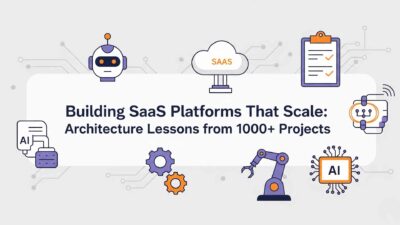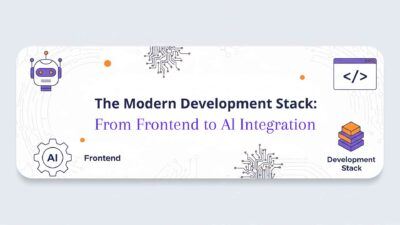The software development landscape is experiencing unprecedented transformation in 2025. As digital transformation accelerates across industries, Full-Stack Development has evolved from a nice-to-have skill to an absolute necessity for modern development teams. The convergence of artificial intelligence, cloud computing, and emerging technologies is reshaping what it means to be a full-stack developer, creating both opportunities and challenges that require strategic adaptation.
According to recent industry data, Full-Stack Development roles have grown by 30% year-over-year and remain among the top 5 most in-demand tech skills. This explosive growth reflects businesses’ urgent need for versatile developers who can navigate complex technical ecosystems while delivering end-to-end solutions that drive real business value.
Table of Contents
The Modern Full-Stack Paradigm Shift
Traditional Full-Stack Development focused primarily on front-end and back-end technologies with basic database knowledge. Today’s full-stack developers must master an entirely different skill ecosystem that includes artificial intelligence integration, cloud-native architectures, DevOps practices, and emerging technologies that didn’t exist just a few years ago.
In 2025, Full-Stack Development is becoming an all-rounder skillset that blends coding with business logic, DevOps with AI, and design thinking with technical implementation. This evolution requires developers to think beyond individual technologies and understand how entire systems work together to create scalable, intelligent applications.
Core Technologies That Define 2025 Full-Stack Development
JavaScript Ecosystem: The Universal Foundation
JavaScript continues to dominate Full-Stack Development, but its applications have expanded far beyond traditional web development. Modern JavaScript frameworks and runtime environments now power everything from mobile applications to server-side APIs and artificial intelligence implementations.
React.js remains the most popular front-end framework, offering component-based architecture that scales efficiently for large applications. Its virtual DOM implementation and extensive ecosystem of libraries make it ideal for building dynamic, responsive user interfaces that meet modern user expectations.
Node.js has solidified its position as the preferred server-side JavaScript runtime, enabling developers to use the same language across the entire stack. Its event-driven, non-blocking I/O model makes it particularly effective for real-time applications and microservices architectures.
Next.js has emerged as the go-to framework for production-ready React applications, offering server-side rendering, static site generation, and built-in optimization features that improve performance and SEO capabilities.
Full-Stack Framework Dominance: MERN and MEAN
The MERN stack is a well-known and powerful software development stack for creating dynamic web applications. It comprises four technologies: MongoDB, Express.js, React, and Node.js. Each component contributes significantly to building robust, scalable applications that can handle modern business requirements.
MongoDB provides flexible, document-oriented data storage that adapts to changing business needs without rigid schema constraints. Its JSON-like format makes data manipulation intuitive for JavaScript developers.
Express.js offers a lightweight, flexible framework for building server-side applications and APIs. Its minimalist approach allows developers to structure applications according to specific requirements while maintaining high performance.
The MEAN stack presents an alternative approach, replacing React with Angular for front-end development. One of the key advantages of the MEAN stack is its ability to use JavaScript on both the client and server sides, which reduces the need for developers to switch between different programming languages. This consistency streamlines development processes and reduces context switching overhead.
Artificial Intelligence Integration: The Game Changer
According to Gartner, by 2025, 80% of enterprises will utilize AI-driven applications to enhance operational efficiency and customer engagement. Artificial intelligence is no longer an optional add-on for Full-Stack Development—it’s becoming a core competency that determines competitive advantage.
AI-Powered Development Tools
Modern Full-Stack Development incorporates AI at multiple levels. GitHub Copilot and similar AI coding assistants provide intelligent code suggestions, automated debugging, and pattern recognition that accelerates development cycles while reducing errors.
Intelligent User Interfaces
AI-powered chatbots and virtual assistants are becoming standard components of modern web applications. These systems use natural language processing to provide 24/7 customer support, automate routine inquiries, and deliver personalized user experiences that adapt to individual preferences and behaviors.
Predictive Analytics and Machine Learning
Full-stack developers increasingly need to integrate machine learning capabilities directly into applications. This includes implementing recommendation engines, predictive analytics dashboards, and automated decision-making systems that provide business intelligence and enhance user engagement.
Cloud-Native Architecture and DevOps Integration
DevOps represents a crucial transformation in modern development that full-stack developers need to embrace to stay competitive. The integration of development and operations practices is fundamental to building scalable, reliable applications that can adapt to changing business requirements.
Serverless Computing Revolution
By 2025, 50% of global enterprises will adopt serverless computing to enhance agility. Serverless architecture eliminates infrastructure management overhead, allowing developers to focus on business logic while automatically scaling applications based on demand.
Containerization and Microservices
Docker and Kubernetes have become essential tools for Full-Stack Development. Container-based deployment ensures consistent environments across development, testing, and production while microservices architecture enables independent scaling and deployment of application components.
Continuous Integration and Continuous Deployment (CI/CD)
Modern Full-Stack Development requires automated testing, building, and deployment pipelines. CI/CD practices ensure code quality, reduce manual errors, and enable rapid delivery of features and bug fixes.
Database Technologies and Data Management
Database Management Systems form the backbone of modern applications, and Full-Stack Development in 2025 requires expertise across multiple database paradigms.
NoSQL and Document Databases
MongoDB and similar document databases offer flexibility for applications with evolving data structures. Their schema-less design accommodates rapid iteration and complex data relationships that traditional relational databases struggle to handle efficiently.
Graph Databases and Real-Time Data
Neo4j and other graph databases enable Full-Stack Development teams to build applications that analyze complex relationships and patterns in data. Real-time databases like Firebase provide instant synchronization across multiple clients, essential for collaborative applications and live updates.
Data Lake and Analytics Integration
Modern applications increasingly require integration with data lakes, analytics platforms, and business intelligence tools. Full-stack developers must understand how to connect applications to these systems while maintaining performance and security standards.
Low-Code and No-Code Integration
The market for low-code solutions is expected to reach over $148 billion by the end of the year, driven by platforms like Mendix, OutSystems, and Microsoft Power Apps. Rather than replacing traditional development, these platforms are becoming tools that enhance Full-Stack Development productivity.
Hybrid Development Approaches
Experienced Full-Stack Development teams use low-code platforms for rapid prototyping and non-critical components while maintaining custom code for complex business logic and performance-critical features.
API-First Development
Low-code platforms excel at consuming and exposing APIs, making API-first architecture essential for Full-Stack Development strategies. This approach enables seamless integration between custom applications and low-code solutions.
Internet of Things (IoT) and Edge Computing
The Internet of Things (IoT) is a primary factor driving innovation in Full-Stack Development. Connected devices generate massive amounts of data that applications must process, analyze, and act upon in real-time.
Edge Computing Integration
Full-stack applications increasingly need to process data at the edge, closer to where it’s generated. This reduces latency and bandwidth requirements while enabling real-time decision-making for IoT applications.
Device Management and Security
Full-Stack Development teams must understand IoT protocols, device management systems, and security considerations for connected applications. This includes implementing secure authentication, encrypted communication, and device lifecycle management.
Progressive Web Applications and Mobile-First Development
Progressive Web Apps (PWAs) represent the convergence of web and mobile application development. These applications provide native-like experiences while maintaining the reach and accessibility of web technologies.
Service Workers and Offline Capabilities
Modern Full-Stack Development requires implementing service workers that enable offline functionality, background synchronization, and push notifications. These features ensure applications remain useful even when network connectivity is unreliable.
Responsive Design and Performance Optimization
Mobile-first design principles are no longer optional in Full-Stack Development. Applications must deliver excellent experiences across all device types while maintaining fast loading times and smooth interactions.
Security-First Development Practices
Cybersecurity has become a fundamental consideration in Full-Stack Development. With increasing cyber threats and regulatory requirements, security cannot be an afterthought—it must be integrated throughout the development lifecycle.
Authentication and Authorization
Modern applications require sophisticated authentication systems that support multi-factor authentication, single sign-on, and role-based access control. OAuth 2.0 and JSON Web Tokens (JWT) have become standard implementations.
Data Protection and Privacy Compliance
Full-Stack Development teams must understand and implement data protection measures that comply with regulations like GDPR, CCPA, and industry-specific requirements. This includes data encryption, audit logging, and privacy-by-design principles.
Emerging Technologies Shaping the Future
Voice Interfaces and Conversational AI
Voice User Interfaces (VUI) and Voice Search Optimization are becoming increasingly common thanks to advancements in generative AI. Full-stack applications must accommodate voice inputs and provide audio outputs that enhance accessibility and user convenience.
Augmented Reality and Virtual Reality Integration
AR and VR technologies are expanding beyond gaming into business applications. Full-Stack Development teams increasingly need to integrate immersive experiences into traditional web applications, particularly for e-commerce, education, and training platforms.
Blockchain and Decentralized Applications
While blockchain adoption varies by industry, Full-Stack Development increasingly includes understanding distributed ledger technologies, smart contracts, and decentralized application architecture.
Development Tools and Environment Evolution
Integrated Development Environments (IDEs) and Code Editors
Modern Full-Stack Development relies heavily on sophisticated development tools that integrate debugging, version control, and collaboration features. Visual Studio Code has emerged as the dominant editor, offering extensive plugin ecosystems and integrated terminal capabilities.
Version Control and Collaboration
Git remains the standard for version control, but Full-Stack Development teams increasingly use advanced Git workflows, automated code review processes, and integrated project management tools that streamline collaboration.
Testing and Quality Assurance
Automated testing frameworks have become essential for Full-Stack Development. This includes unit testing, integration testing, end-to-end testing, and performance testing that ensures application reliability and user experience quality.
Skills Development and Career Preparation
Technical Skills Foundation
Successful Full-Stack Development in 2025 requires mastery of core web technologies including HTML, CSS, and JavaScript, which provide everything needed to master front-end development. However, these fundamentals must be combined with modern frameworks, cloud platforms, and emerging technologies.
Back-End Technology Proficiency
Full-stack developers must be proficient in at least one server-side language and framework combination. Popular choices include Node.js with Express.js, Python with Django or Flask, Java with Spring, and C# with .NET.
Database and Data Management Skills
Modern Full-Stack Development requires understanding both relational and NoSQL databases, data modeling principles, and integration with analytics and business intelligence platforms.
Performance Optimization and Scalability
Frontend Performance Optimization
Modern applications must load quickly and respond smoothly across all devices and network conditions. This requires understanding of code splitting, lazy loading, image optimization, and content delivery networks (CDNs).
Backend Scalability and Reliability
Full-Stack Development teams must design applications that can handle increasing loads while maintaining performance and reliability. This includes understanding caching strategies, load balancing, and horizontal scaling approaches.
Monitoring and Observability
Production applications require comprehensive monitoring, logging, and alerting systems. Full-stack developers must implement observability practices that provide insights into application performance, user behavior, and system health.
Industry-Specific Considerations
E-commerce and Digital Commerce
Full-Stack Development for e-commerce requires understanding payment processing, inventory management, personalization engines, and compliance requirements. Modern platforms must handle high traffic volumes while providing secure, seamless shopping experiences.
Healthcare and Regulated Industries
Applications in healthcare and other regulated industries require additional considerations for data privacy, audit trails, and compliance reporting. Full-Stack Development teams must understand industry-specific requirements and implement appropriate safeguards.
Financial Services and FinTech
Financial applications require exceptional security, real-time processing capabilities, and integration with banking and payment systems. Full-Stack Development in this sector often involves regulatory compliance and risk management considerations.
Building a Competitive Edge Through Specialization
Domain Expertise Development
While Full-Stack Development provides broad technical skills, career advancement often requires developing deep expertise in specific domains or industries. This specialization enables developers to understand business requirements and deliver solutions that create real value.
Continuous Learning and Adaptation
The rapid pace of technological change requires Full-Stack Development professionals to engage in continuous learning. This includes staying current with framework updates, emerging technologies, and industry best practices.
Open Source Contributions and Community Engagement
Contributing to open source projects and engaging with developer communities provides valuable experience, networking opportunities, and visibility within the Full-Stack Development ecosystem.
The Business Impact of Modern Full-Stack Development
Digital Transformation Acceleration
Full-Stack Development enables organizations to rapidly prototype, develop, and deploy digital solutions that transform business processes and customer experiences. This agility provides competitive advantages in rapidly changing markets.
Cost Efficiency and Resource Optimization
Versatile Full-Stack Development teams can handle diverse projects with fewer specialized resources, reducing development costs while maintaining high-quality outputs. This efficiency becomes particularly important for startups and resource-constrained organizations.
Innovation and Competitive Advantage
Organizations with strong Full-Stack Development capabilities can quickly adopt emerging technologies, experiment with new business models, and respond to market opportunities faster than competitors relying on traditional development approaches.
Full-Stack Development in 2025 represents far more than technical skill acquisition—it embodies a strategic approach to building scalable, intelligent, and user-centric applications that drive business success. The technologies and practices outlined here provide the foundation for thriving in an increasingly complex and dynamic development landscape.
Success requires not just mastering individual technologies, but understanding how they integrate to create comprehensive solutions that solve real business problems. The Full-Stack Development professionals who embrace this holistic approach while staying current with emerging trends will find themselves at the forefront of digital innovation, driving the next generation of transformative applications that shape our digital future.
📧 Email: [email protected]
📞 Phone: 1-347-543-4290
🌐 Website: emasterlabs.com
📍 Address: 1942 Broadway Suite 314 Boulder, CO 80302 USA
Engineer Master Labs – You Think, We Automate, You Profit
Competitors Are Scaling Faster AI





